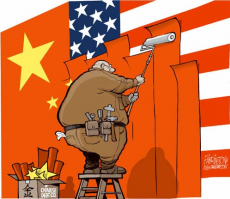
Email: emanuelealbertocirello.98@gmail.com
Total Article : 76
About Me:I am a Year 13 student which aspires to be an architect. I am interested in anything I don't yet know, and I mostly write about art, politics , Italian culture and inspirational people, although I will try to write for as many categories possible, just to test myself and get to know more things.

China has been an early centre of civilisation. It has had a dominant role in history, and as part of the “silk path”, it was a destination where Europeans merchants made extensive relationships, making trade between Europe and Asia durable for many centuries. It has had a dominant role for 2000 years. Its history has been characterised by a succession of emperors and dynasties until when, in 1911, the communist revolution discarder the monarchical system in favour of the government of the Republic of China.
The victory was soon compromised by concessions on the part of the Chinese bourgeoisie, and the country entered a period dominated by the Northern Warlords, headed by Yuan Shikai. Since the founding of the People's Republic of China in 1949, China has entered a new Communist era of stability, with the Reform and Opening Up policies of 1978, bringing in China’s phenomenal economic growth.
In the year of 1949 the once “Republic of China” became the “People’s republic of China”, as the Communist party chairman Mao Zedong took power. His principles in ruling China, was that development and industrialization were the highest priority. Mao believed that by advancing in economic development was the only way to overcome what he perceived as the nation’s backward “feudal” past. He was certain that from the help of technology and science he would be able to lead his country towards a more successful future. As China turned into the People’s Republic of China, is was the beginning of a three decade long period of socialist central economy. Following the Soviets guiding principles, China now pursued industrialization under the Soviet-style. The process was heavily influenced by the Marxist ideology of social equity, which was “abolition of the separation of town and country”.
Deng Xiaoping who took over power after Mao in 1978 also believed that the advance in industrial development was the only solution to stand on equal grounds with the other developing countries, although the ways in which he strived to achieve his goal differed greatly from his predecessor. The reasons to why both leaders were so desperate in developing China was because of the delay China had in industrialization, compared to their surrounding countries. In the twentieth century while the other countries around China were urbanizing and industrializing, China remained the primary rural, agrarian nation. Starting from the years of 1978, China went into the reform era where it drastically changed the country turning it into one the most industrialized countries in the world. In this era millions of former agricultural workers quit their jobs, in order to work in the millions of small-scale factories that China made, throughout the countryside.
China has experienced three major phases since the People’s Republic of China was built in 1949. As Mao rose into power in 1949, the state started the confiscation of land from the landlords and re-distributed to the peasants equally in order to improve both equity and efficiency. This was the time when China was facing political isolation and economic ban. In this era the political leaders adopted from the soviets two development strategies. One was the prioritization of heavy industrial development, in order to catch up with the developed western countries. The second was to create a grain self-sufficiency policy to reduce the countries reliance on buying from international markets.
Under the ruling of Mao Zedong, China maintained a centrally planned economy, and only after the introduction of economic reforms the country opened up to the world in economic terms. Beginning in 1979, China launched several economic reforms. The central government initiated price and ownership incentives for farmers, which enabled them to sell a portion of their crops on the free market. In addition, the government established four special economic zones along the coast for the purpose of attracting foreign investment, boosting exports, and importing high technology products into China.
China has, in the previous decades, had uneasy relations due to its communist and social political nature. The political orientation of the country, and its strict relationship with Russia has not always been appreciated by Western economies, due to their attempt to destabilise communist countries. However, since the introduction of economic reforms and the end of the leadership by Mao Zedong, western countries and their TNC’s have gained great benefits from China and its industrialisation, building more stable, profitable and less hostile relationships.
China is currently one of the main international investors in the African continent and has recently opened its markets to African trade. As of 2012, China foreign direct investment in Africa reached $2.5 billion and China’s trade with Africa, in the same year, was the highest in the world for an individual nation with $156.4 billion.
Their economic development has also put their major cities such as Beijing and Shanghai on the world’s map in regards of new technologies. China is currently a global hub where not only companies invest in manufacturing industries but also in the technological and quaternary sector.
It is therefore visible that China has come a long way from the days of isolation and economic stubbornness, and its future as a superpower is clear and imposing, perhaps threatening the interests of already existing superpowers.
Image reference: https://www.tes.com/lessons/OGLxQkPp8QfKjQ/china-the-new-world-superpower

0 Comment:
Be the first one to comment on this article.